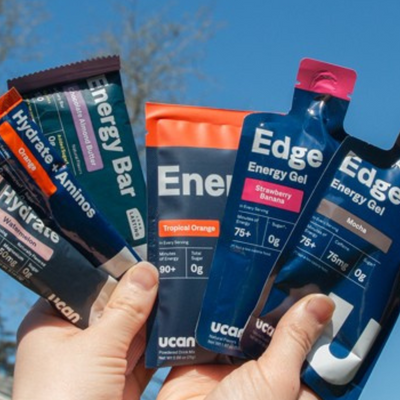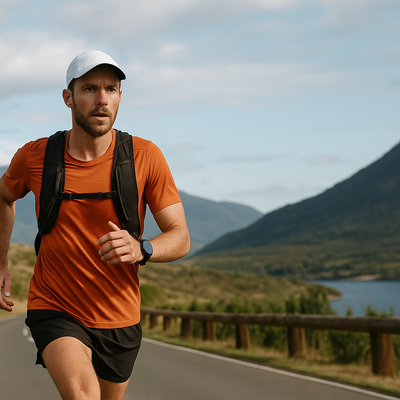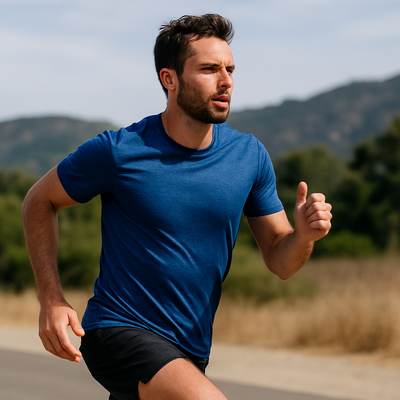Running in hot weather presents a unique challenge for endurance athletes. From increased sweat rates and dehydration risk to a higher perceived effort, training in the heat demands preparation and the right strategies. But with the right tools and mindset, running in the heat can build resilience, improve cardiovascular fitness, and even boost race-day performance. In this guide, we’ll explore practical tips for running in heat, the science-backed benefits of heat training, and how to stay safe, fueled, and hydrated with help from UCAN.
Why Is Running in the Heat So Challenging?
When temperatures rise, your body works harder to regulate internal temperature. More blood is directed to the skin for cooling through sweat, reducing the supply to working muscles. As a result, you fatigue more quickly, your heart rate rises, and your pace often drops—especially without proper hydration and fueling strategies. According to a 2019 study published in Temperature, even mild dehydration can impair endurance performance and cognitive function.¹
The Benefits of Running in Heat (Yes, Really)
While it may feel like a grind, heat training has surprising upsides:
-
Improved cardiovascular efficiency: Your heart adapts to pumping more blood with each beat under stress.
-
Increased plasma volume: More fluid in your system helps with thermoregulation and endurance.
-
Mental toughness: The psychological challenge of running in hot, humid conditions builds grit that transfers to cooler race days.
-
Better sweat response: Over time, you sweat earlier and more efficiently to cool down.
One study found that runners acclimated to heat could improve time trial performance by over 5% in cooler conditions.² That’s the difference between a PR and a mid-pack finish.
10 Essential Tips for Running in the Heat
1. Hydrate Before, During & After
Start your run already hydrated. Drinking water alone may not be enough—especially when you sweat heavily and lose essential electrolytes. That’s where UCAN Hydrate comes in. With 5 key electrolytes and zero sugar, it supports optimal hydration and replenishment without spiking your blood sugar.
Pre-run tip: Sip 12–16 oz of water with one serving of UCAN Hydrate 60 minutes before heading out.
2. Fuel Right, Even in the Heat
It’s tempting to skip fueling in the heat, especially when appetite drops. But your body still needs steady energy. UCAN Energy Gels use LIVSTEADY™, a steady-release carb that keeps your energy levels balanced without sugar crashes or stomach issues—ideal for hot runs when digestion can be compromised.
Pro tip: Take one Energy Gel every 45–60 minutes during long runs, and follow with a few sips of water.
3. Time Your Run Wisely
Aim for early morning or late evening when temperatures are lower and UV exposure is reduced. Midday sun can make even short runs feel punishing. Check the “feels like” temp, which accounts for humidity—a key factor in perceived effort.
4. Dress for the Heat
Choose light-colored, loose-fitting technical fabrics that wick away sweat and allow ventilation. Avoid cotton, which traps moisture. A hat or visor and sunglasses will help reduce sun glare and overheating.
5. Apply (and Reapply) Sunscreen
Use sweat-resistant, broad-spectrum SPF 30+ on all exposed areas. Sunburn not only damages skin but also impairs thermoregulation.
6. Slow Down Your Pace
Heat increases your heart rate and perceived exertion, so don’t expect to hit your normal splits. It’s smart (not weak) to slow your pace and shift focus to effort over pace on hot days.
7. Acclimate Gradually
Don’t jump into long runs at high noon. Spend 7–14 days slowly increasing your exposure, starting with short runs in the heat to allow your body to adapt.
8. Know the Warning Signs
Heat exhaustion and heat stroke are serious. Watch for:
-
Dizziness or headache
-
Chills or goosebumps
-
Confusion or disorientation
-
Nausea
-
Stop running and seek shade and fluids if any symptoms occur.
9. Use Cooling Tactics
Run near shaded routes, wear ice bandanas, and splash water on your head and wrists mid-run to help cool your core temperature.
10. Refuel and Rehydrate Immediately
After your run, prioritize recovery with a mix of fluids, electrolytes, and carbs. A cold serving of UCAN Hydrate and a protein-rich snack helps jumpstart recovery and replace what you lost in sweat.
Best UCAN Products for Running in Heat
| Product | Benefit | When to Use |
|---|---|---|
| UCAN Hydrate | Replenishes electrolytes without sugar | Before, during, and after runs |
| UCAN Energy Gels | Long-lasting fuel, no sugar crashes | Every 45–60 mins during training |
FAQ: Running in the Heat
Q: Is it safe to run in high temperatures?
A: Yes, if you’re smart about it—run early, hydrate, fuel properly, and listen to your body.
Q: Can I build endurance by running in the heat?
A: Yes! Heat training boosts cardiovascular adaptations, improving fitness for cooler temps.
Q: Should I drink only water when it’s hot?
A: No. You also need electrolytes—especially sodium—to stay hydrated and maintain performance.
Q: How long does it take to acclimate to hot weather?
A: Typically 7–14 days of gradual exposure. Start with easy runs and increase duration slowly.
Q: Are energy gels safe in hot weather?
A: Yes—especially UCAN’s, which are easy on the stomach and won’t spike blood sugar.
Final Thoughts
Running in the heat doesn’t have to be a sufferfest. With the right hydration strategy, smart pacing, and steady fueling from UCAN products, you can turn hot summer training into a performance advantage. Embrace the heat—but train smart.
References
-
Lieberman, H. R., et al. (2019). Hydration and Human Performance. Temperature.
-
Lorenzo, S., et al. (2010). Heat acclimation improves exercise performance. Journal of Applied Physiology.
-
Runner’s World. Running in the Heat
-
McMillan Running. A Runner’s Guide to Running in the Heat







